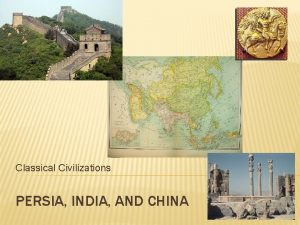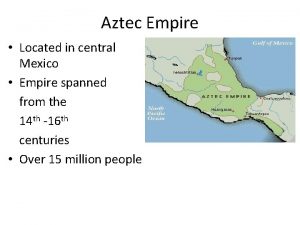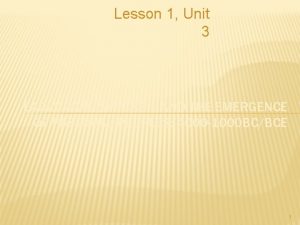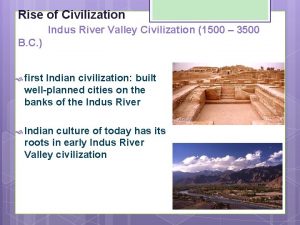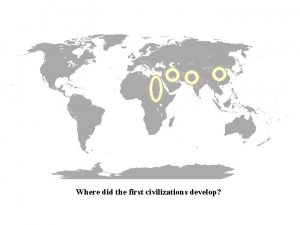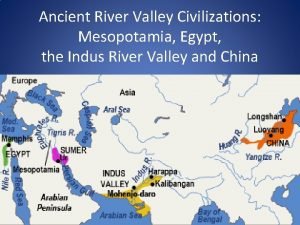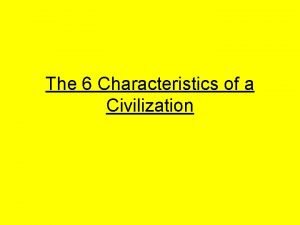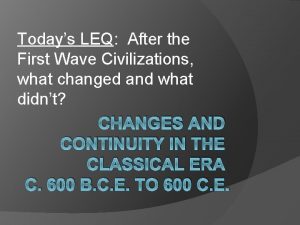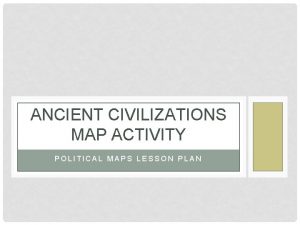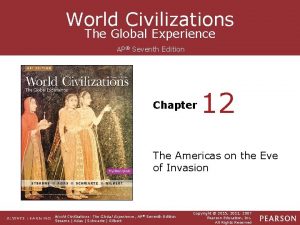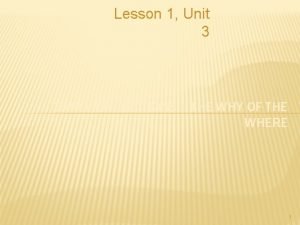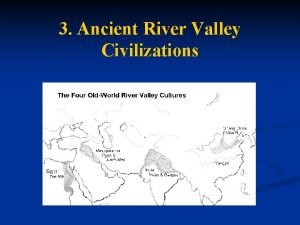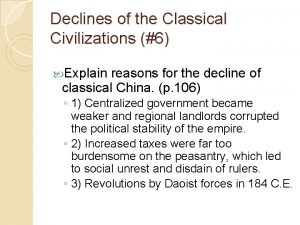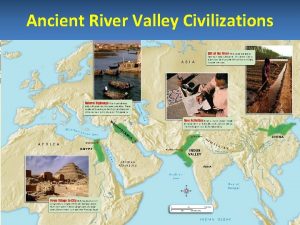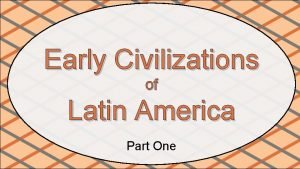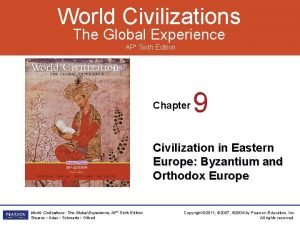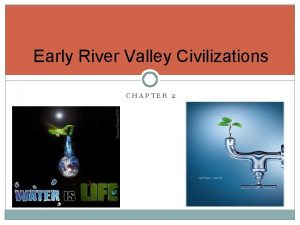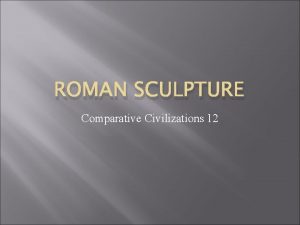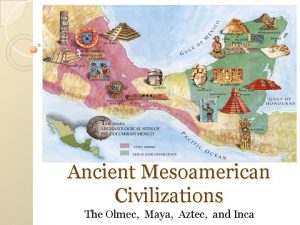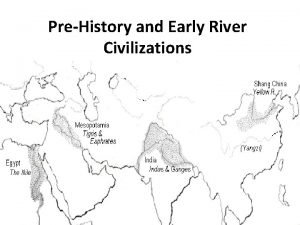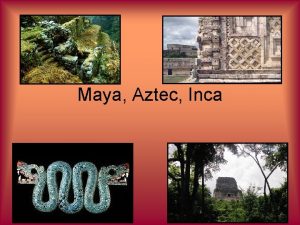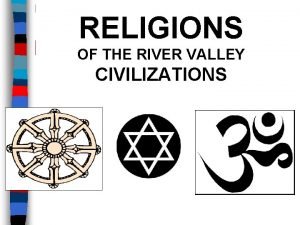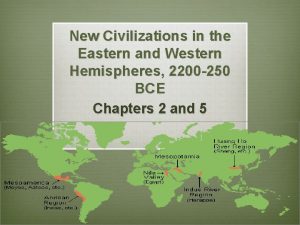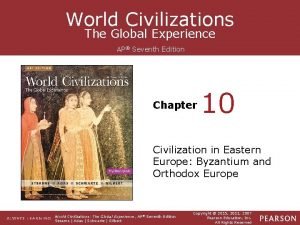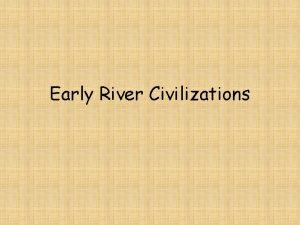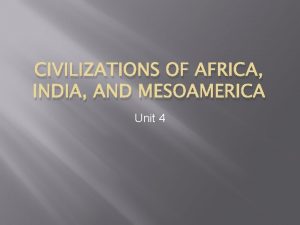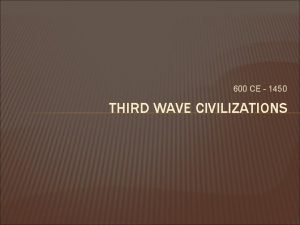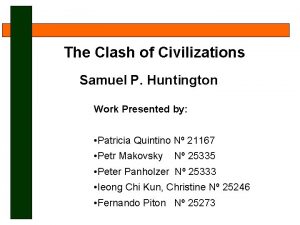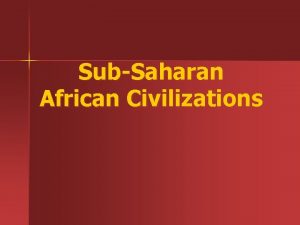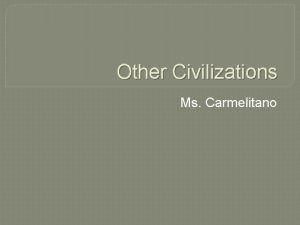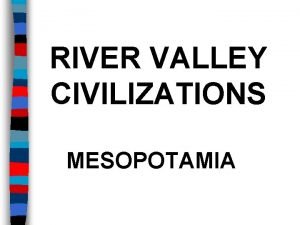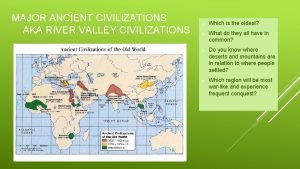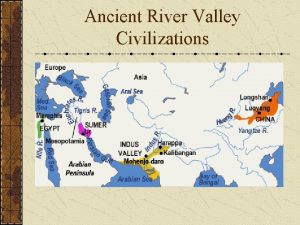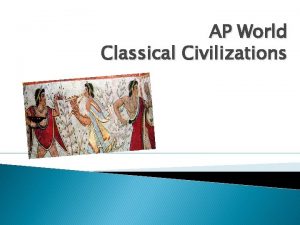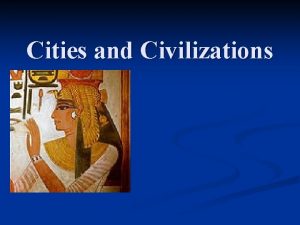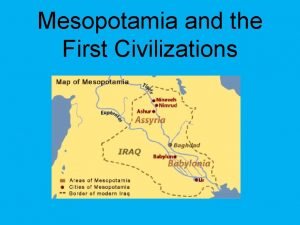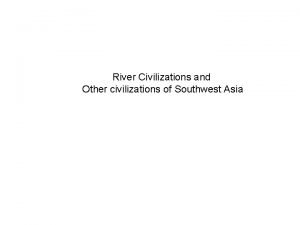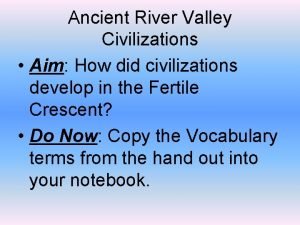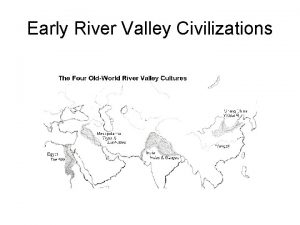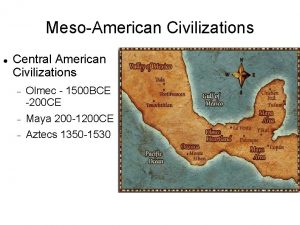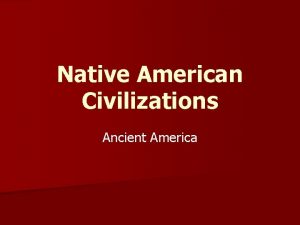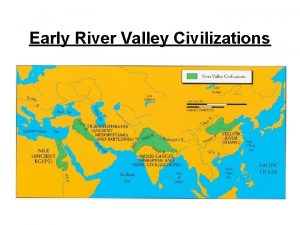Where were these civilizations located Where were these































- Slides: 31


Where were these civilizations located?

Where were these civilizations located?

Where did ancient civilizations build? Many built theirs near rivers. The Maya built in the jungles. The Aztec built on a swampy island The Inca built high in the Andes.

Maya

Maya v The Mayan Empire existed between 1600 B. C to 900 A. D. v Their communities were in parts of what is now southern & Eastern Mexico (Yucatan Peninsula), western Honduras, Guatemala, El Salvador & Belize.

Maya v The Maya were a highly religious people and much of what they did was centered around their beliefs. v Their agriculture, art, architecture, farming and science was all influenced by their religious beliefs.

v The Maya used a base 20 system. (We use a base 10) Maya v They also wrote their numbers vertically. (We write horizontally) v They were the first civilization to use a symbol for zero.

v The Maya are well known for their calendars. They actually used 3 different calendars! Maya v The first calendar recorded all the events from the beginning of the Maya and had 360 days in it (18 months of 20 days each). This is the one that “ran out” in December 2012. v The second calendar was a sacred one, . It was 260 days and it was used for religious reasons. v The third calendar was a civil one, and was also 360 days. A five day month was added to the end of the year for a total of 365. This was considered an unlucky month and no work or bathing was done during it. It was used for most calculations.

Maya v The Maya invented the most advanced form of writing in the ancient Americas. They used hieroglyphics. v The Mayas used about 700 symbols or glyphs. A glyph is a picture or a symbol used to represent a sound, a word, or perhaps a syllable.

Maya v Hieroglyphics covered their steleas, the big stone slabs they built to tell the story of special occasions and events.

Maya v The Maya wrote books about their gods, their leaders, their daily life, and their special events. v They were not like the books we have today. Maya books were made of soft bark and were folded like a fan. The reader had to unfold them to read them. v Books included drawings as well as glyphs. A book was called a codex.

Maya v No one knows exactly what happened to the Maya Civilization. v What is known is that the major cities that were built were abandoned and the population dispersed over Latin America, and possible even further. v There are still cultural ties to the Maya although there are no Mayan towns or people groups remaining.

Aztec

Aztec • The Aztec lived in Central Mexico for over 100 years until the Spanish arrived in the 1500’s. • The capital, Tenochtitlan, was extremely modern for its time. It had over 200, 000 inhabitants. • It was built on an island in the middle of a swamp which helped protect it from enemy attacks.

Aztec • The Aztec were fierce warriors who conquered many of the tribes around them. • The dominant tribe was the Mexica, which is where the country gets its name from. • They believed if one died in battle it was a tribute to their god of war.

Aztec • Because of the swampy land around the capital, farming was difficult, so the Aztecs built floating gardens called chinampahs.

Aztec • They grew crops such as maize, beans & squash. • They also raised turkeys, ducks & dogs for food.

Aztec • The Aztecs had two calendars. • The first was called the xiuhpohualli, and had 365 days. It described the days and rituals related to the seasons. • The other calendar had 260 days. It was called the tonalpohualli or the day-count.

Aztec • When the Aztecs started a new settlement, there were two things they would do. 1. Build a shrine to the god Huitzilopochtli 2. Build a ball court next to it. • In Tenochtitlan it was surrounded by the palace and temple. • The Aztec ball game, known as ullamaliztli, was a priority.

Aztec • Another game the Aztecs enjoyed playing was patolli. • This was a board game that used beans to advance around the board. • While both these games were played for fun, they often took on political & religious significance.

Aztec • The Aztec were conquered by Hernan Cortes in 1519. • The leader of the Aztec was Montezuma II. • Many Aztecs died from smallpox.

Inca • The Inca Empire had nearly 12 million people by 1400 A. D. • Their capital, Cuzco, was known as the “City of the Sun” • The Empire stretched along the Andes Mountains

Inca • The Inca used a system of knotted strings known as quipu to send messages around their empire. • The number and shape of the knots and the colors of the strings helped to remind messengers of the contents of the messages

Inca • The Inca built a system of stone roads connecting their communities across the mountains. • They had no written language nor vehicles with wheels so they relied on runners to carry verbal messages.

Inca • Incas were known for their building skills. • They built stone terraces to create flat spaces to farm. • They built irrigation canals to bring water to the crops. • They cut huge stones to build their cities. • Machu Picchu is 8000 feet above sea level.

Inca • The average Inca owned no land could not own or run a business. • Laws specified who could work, where they worked and when they worked. • The Inca farmed the land owned by the Emperor. • They were allowed to keep about 1/3 of their harvest, while the majority when to support others. • Taxes were paid in labor, not money.

Inca • The Inca had no cows or horses. • The most important animal to the Inca was the llama.

Inca • Llamas were used to transport goods. • Llamas were used as sacrifices (unlike humans in the other ancient civilizations). • Llama wool was used to make thread for weaving.

Inca • Llamas were used to transport goods. • Llamas were used as sacrifices (unlike humans in the other ancient civilizations). • Llama wool was used to make thread for weaving.

Inca • The last emperor of the Inca was Atahualpa. • He attempted to make a deal with Francisco Pizarro to buy his freedom. • Pizarro took the treasure, but killed Atahualpa and captured Cuzco.
 Which civilizations were the first to record measurements
Which civilizations were the first to record measurements What is it
What is it What countries surround greece
What countries surround greece Where were the aztec located
Where were the aztec located Unit 3 lesson 1 sumer and mesopotamia
Unit 3 lesson 1 sumer and mesopotamia River valley civilizations characteristics
River valley civilizations characteristics River valley civilizations
River valley civilizations Where did the first civilizations develop
Where did the first civilizations develop 4 river valley civilizations
4 river valley civilizations Characteristics of civilization
Characteristics of civilization Third wave civilizations
Third wave civilizations Ancient civilizations map activity
Ancient civilizations map activity World civilizations the global experience 7th edition
World civilizations the global experience 7th edition Geographic luck definition
Geographic luck definition What is believed to be the 1 stdynasty of ancient china?
What is believed to be the 1 stdynasty of ancient china? What caused the decline of classical civilizations
What caused the decline of classical civilizations Ancient river valley civilizations powerpoint
Ancient river valley civilizations powerpoint Early south american civilizations
Early south american civilizations World civilizations the global experience ap edition
World civilizations the global experience ap edition Chapter 2 early river valley civilizations
Chapter 2 early river valley civilizations Comparative civilizations 12
Comparative civilizations 12 Olmec maya aztec inca timeline
Olmec maya aztec inca timeline River valley civilizations map
River valley civilizations map Aztec maya inca map
Aztec maya inca map Which cultures believe in reincarnation
Which cultures believe in reincarnation Mediterranean civilizations location hemisphere
Mediterranean civilizations location hemisphere World civilizations the global experience 7th edition
World civilizations the global experience 7th edition Tigris euphrates and nile river
Tigris euphrates and nile river Quipus
Quipus Third wave civilizations time period
Third wave civilizations time period Chapter 9 lesson 1 ancient india
Chapter 9 lesson 1 ancient india Clash of civilizations huntington
Clash of civilizations huntington

